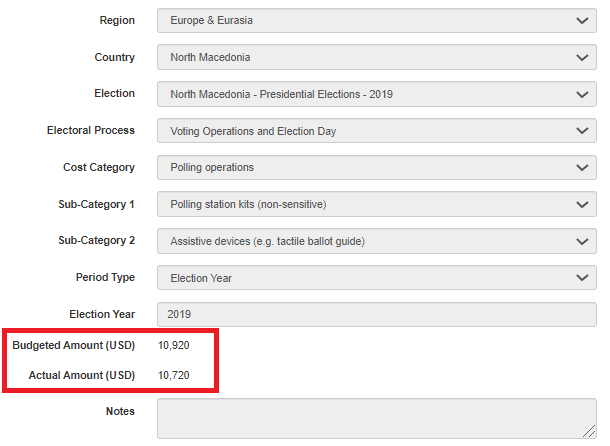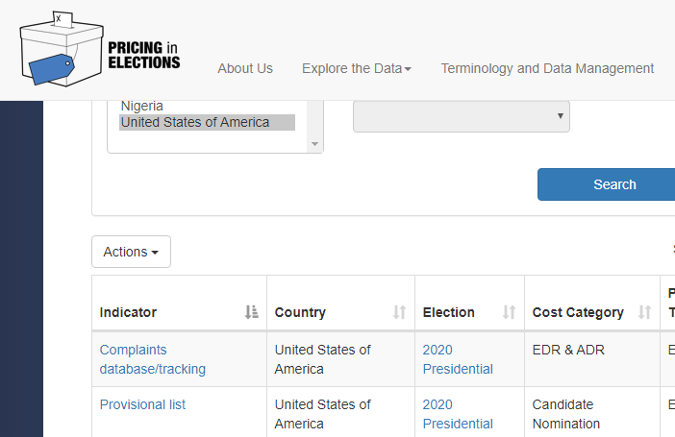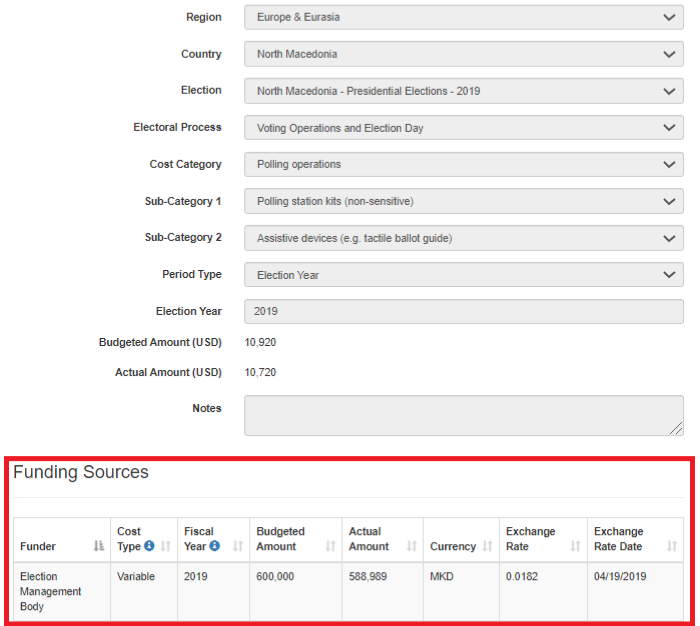About the Data
The International Foundation for Electoral Systems (IFES) leverages its broad network of field offices and partnerships to obtain accurate election budgets and financial reports from Electoral Management Bodies (EMBs) and other relevant public institutions, and consent from relevant authorities to publish these data. Local election experts and IFES staff then analyze and categorize data points according to a standardized Manual on Terminology and Data Categorization to ensure consistency and accuracy. The Manual is publicly accessible through the below link and includes definitions of all indicators included in the Pricing in Election Database.
Manual on Terminology and Data Categorization
Navigating the Database
The Pricing in Election Database is built for a wide range of actors – from election administrators and donors to academics, journalists, and advocates for inclusive election processes. In order to serve their diverse needs, the developers have created multiple search options, and incorporated special data categories into the Database, which are outlined below.
Searching the Database – Finding Results by Type of Election
Every year, a broad range of elections are held from the national down to the local level. The Pricing in Election Database can be used to view and analyze data specific to the following types of events:
- Presidential – Executive branch at the national level
- Lower House – Legislative branch at the national level
- Upper House – Second (and generally weaker) house of the legislative branch at the national level4
- Legislative Assembly – For unicameral legislative branch
- Constituent Assembly – Body composed to draft and adopt a constitution
- Referendum – Direct vote of the electorate required by the legal framework or requested by the Executive or Legislative on an issue of public policy5
- Governor – Executive branch at the state or provincial level
- State Provincial Assembly – Legislative branch at the state or provincial level
- Mayor – Executive branch at the local or municipal level
- Municipal Council – Legislative branch at the local or municipal level
- General (Multiple, Synchronized) Elections – Elections held for more than once of the above at the same time (e.g. Presidential Election and Legislative Assembly, or Legislative Assembly and State/Provincial Assembly)
Use the Explore the Data - Elections page to locate budget and expenditure data specific to event type. Results can be further filtered by country.
Searching the Database – Breaking Down Expenses by Electoral Process or ‘Phase’ and Cost Category
At the highest level, the database breaks election costs down into 8 buckets, reflecting key electoral processes that unfold during an election cycle:
- Electoral Management Body Operations and Institutional Development
- Voter Registration
- Delimitation
- Candidate Nomination
- Election Campaigns
- Voting Operations and Election Day
- Results Management & Transmission
- Electoral Dispute Resolution and Alternative Dispute Resolution
Users seeking to understand the costs of specific phases or processes within an election may find these Electoral Process classifications to be the most valuable. To view a full list of the cost categories, and cost sub-categories nested under each of these eight primary topics, access the Manual on Terminology and Data Categorization through the link above or visit the Explore the Data - Cost Categories page. Sub-categories will capture costs associated with enhanced inclusion (e.g., translation of materials into braille, provision of ramps at polling stations, outreach to marginalized populations) and integrity (e.g., expenditure on cybersecurity and price of biometric voter registration tools).
Searching the Database – Using Contextual Filters under the Advanced Search Function
Each country has a unique legal framework to guide its election processes. IFES developed a set of ‘contextual filters’ available through an advanced search function in the database, located at the top of both the Explore the Data - Elections and Explore the Data - Cost Categories page pages.
These filters will allow users to further refine their search results and conduct comparative research. For example, users can choose to filter results based on whether voter registration is a continuous or periodic undertaking, or whether an electoral management body operates as part of the government or independently from it. A full list of contextual filters that can be used to refine database searches can be found in the Manual on Terminology and Data Categorization, available through the link above.
Understanding the Database – Budgeted Verses Actual Costs
The Database distinguishes between budgeted costs for election expenses, and actual costs. Budgeted costs represent the planned expenses for electoral procedures or materials and are based on past expenditure, markets rates, and other sources of cost information. The actual amounts reported are expenses that have been incurred during the election cycle, and so they represent real costs. Common sources of information on actual expenses include official financial reports from election management bodies and other institutions, as well as audit reports.

Understanding the Database – Defining the Electoral Cycle
Wherever possible, the database reports on costs for entire election cycles, rather than just for a single election year, because significant investments are made to electoral processes even in years without electoral events.
For the purposes of this database, an election cycle includes the Pre-election period, Election Period, and Post-election Period.
To capture Pre-election costs, we set the start date for an election cycle to the first day of the fiscal year that follows a previous election for the same office(s). For example, if presidential election were held in July 2019, and the country’s fiscal year re-started in September, we would set the beginning of the election cycle to September 1, 2020.
Activities completed during the Post-election period can extend for a significant time, and there can be overlap across cycles. As such, we define the end of the electoral cycle as either:
- the completion of any post-election audits;
- the deadline for the submission of applications for ADR/EDR (where there is no deadline for the resolution of disputes); or
- the deadline for the resolution of disputes - whichever is the later.
To ensure that other Pre and post-election activities are captured, the Electoral Process category for ‘Electoral Management Body Operations and Institutional Development ‘ records costs of activities such as post-election review, continuous implementation of the EMB’s mandate such as legal and regulatory reform, as well as institutional strengthening and professional development, and research. Voter list updates are recorded under the Voter Registration cost-category.
Understanding the Database – Accessing Information on Funding Sources and Type of Expense
Whether planning for an election cycle or advocating for reform, it is important to understand not only the overall price tag of a process or commodity – but also how elections are funded. Wherever possible, the Pricing in Elections Database captures whether resources are allocated within the budgets of the specific government agencies or institutions besides the election management body, such as the judiciary, the Ministry of Interior, Ministry of Justice, or police/security forces. It also captures, where data are available, if international sources provide additional resources. To view this information, click on the indicator of interest. The ‘Funding Sources’ table will be located at the bottom of the page.


The table will further define whether a cost is categorized as core, variable, or diffuse, according to the following definitions.
- Core costs: Costs incurred by an election management body that are associated with maintaining an electoral infrastructure between elections, such as costs for office space and permanent staff.
- Variable costs: Costs incurred by an election management body that are driven by an election event or electoral process, such as biometric voter registration.
- Diffuse costs: Costs of services that contribute to the conduct of elections that are incurred by public agencies or departments other than the election management body, such as additional election security costs expended by a Ministry of Interior when deploying the country’s police force.
This detail is particularly valuable for budget planning purposes, as core costs capture day to day expenditures throughout election cycles, and variable costs will capture the actual expenses of carrying out a discreet electoral event. The diffuse cost category captures financial information on the costs of elections that might otherwise be overlooked, as their incorporated into budgets outside of election management bodies’ purview.